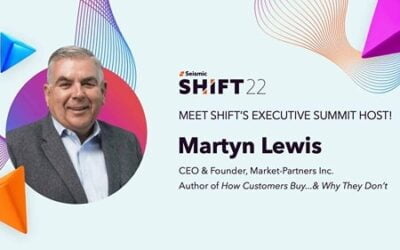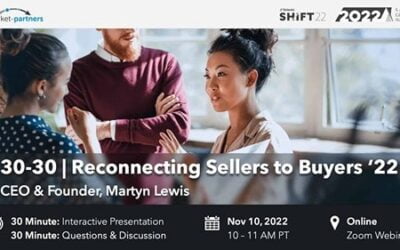Every year, the Customer Buying Journey becomes a hotter and hotter topic of discussion within the business world. And while we, as one of the earliest proponents of and educators on the buying journey, are thrilled to see it catch on in such a big way, we also can’t help but notice two worrying aspects surrounding these conversations.
First, much of the readily available information being written and shared on the buying journey only gives a surface level explanation of this incredibly deep, rich, and integral subject matter. Second, the amount of expertise required to gain a truly comprehensive understanding of the buying journey is being woefully underestimated.
That is why we want to use our two-decades worth of buying journey research to create the best possible resource for mastering Customer Buying Journey. This article will serve as the second in a three-part series, giving in-depth answers to some of the most frequently asked questions about this essential business concept.
1. What is the Customer Buying Journey?
2. How Do You Map the Customer Buying Journey?
3. How Do You Manage the Customer Buying Journey?
Without further ado, let’s dive into some of the most intricate aspects of the buying journey.
Why Do You Map the Buying Journey?
Mapping the DNA of the buying journey is the number one job for any organization interested in optimizing their sales and marketing approaches. Without understanding how the customer is going to buy, a business is essentially leaving everything to inefficient process and chance. Sure, shoot enough arrows in the dark, and some of them might be able to hit a slow-moving target – but it would certainly be easier if you could see the target, knew where it was headed next, and of course, were taught how to use your bow.
How Do You Map the Buying Journey?
There is no substitute for talking directly with buyers and prospects about what happens across their buying journey. This can be trickier than it seems, as many buyers couldn’t tell you much in actual detail; they may have documented their purchase process, yet most customers do not keep track of their end-to-end buying journey.
This is why asking the right questions and listening to the customer is so important. Find out how different players across the organization perceive events and look for benchmarks of how they typically progress through their buying journey. Discover why they do what they do, where and when they get hung up, and why. It’s all there, but it takes detective work, patience, and unbiased eye to pick up on the true, underlying logic. And when you start hearing the same details, the same sequences, the same reasoning – which we can assure you will happen – then you will know you have decoded the DNA.
What is the “DNA” of a Buying Journey?
Over our decades of research, Martyn and the Market-Partners Inc. team have developed a model to effectively decode and create a map for any buying journey. The key is the Buying Journey DNA, which are the six strands (or factors) that comprise and influence all buying journeys.
While the nature of these strands can vary greatly between different markets, a very interesting fact came to light during our investigations. The buying journey for a particular market, when buying a specific offering, will share the same DNA. In fact, a similar DNA code will define a single market, and conversely, if two buyers purchase the same offering but in a different manner, that indicates two distinct markets.
Here are the six strands of the Buying Journey DNA:
Triggers (and Dependencies): the catalysts and prerequisites that initiate and precede a buying journey.
Steps: the activities and stages that a buyer will likely engage in.
Key Players: the relevant individuals and groups across all the steps of the buying journey.
Buying Style: how a buyer determines what and where to buy.
Value Drivers: the motivations of the buyer.
Buying Concerns: the inhibitors that can slow and/or stop the buying journey.
It is the DNA of that particular Customer Buying Journey that forms the basis of a successful market engagement.
It also crucial to restate from the previous installment that strands 3 through 6 all can, and likely will, change with each step of the buying journey.
Where is the Most Friction in most Buying Journeys?
The amount of friction in the buying journey is directly correlated to the amount of effort required to reach the next step. Typically, becoming aware and interested in an offering at an early stage in the buying journey (barring an immediate, glaring objection) is very easy. Seeing an ad, doing cursory research, having a conversation, even listening to a pitch requires little input and few hurdles for a would-be-buyer to overcome. That said, actually committing to an offering requires substantially more effort, and the amount necessary only scales upwards with the size and complexity of the sellers offering and the customer’s organization.
At the point of commitment, your prospect is going to be faced with a laundry list of challenges to work through if they ever hope to align and mobilize their respective organization. They need to: handle all the outside friction and competing agendas, worry about implementation and adoption, manage all the implications of moving forward, continually explain why this purchase is a higher priority than many other initiatives, show why the “status quo” is not good enough, and jump through so many more hoops it’s difficult to even imagine… unless you’ve ever tried to get your own company to adopt anything new.
Ironically, despite this being the time where the buying effort skyrockets, this is usually where the selling effort stops. Most salespeople are busy celebrating a tentative, verbal agreement to purchase, while their “champion” is spinning their wheels due to pushback, just one more no away from deciding this isn’t worth the effort.
What is the Friction in the Buying Journey?
Buying Concerns are probably the most critical facets of the Customer Buying Journey DNA. They are widely overlooked, often trivialized, and usually the least understood aspects – yet explain precisely why customers don’t buy offerings that would unquestionably bring them value. As stated in the definition, these are the inhibitors, the pinch-points that can slow, or even stop, a buying journey. Though they come in all shapes and sizes, but like with all things buying journey, we have found for a specific offering in a given market there is great commonality of buying concerns across each step. After much analysis, we have defined nine categories of buying concerns – any one of which can derail a buying journey from its tracks.
Process: the actual process – purchasing, sourcing, and so on – within the buying organization expressly for the acquisition of this type of product or service.
Priority: the urgency and timing of the purchase, and how it aligns with the organization’s current and upcoming directives, strategies, and goals
Individual: the personal motivations and objections of the individual “carrying the ball” at any stage of the buying journey.
Organizational: the “political” friction, including all the various agendas, objections and concerns that are likely to arise across the organization.
Alternatives: any and all alternatives an organization may consider before they move forward with a particular acquisition, including doing nothing.
Business: the fiscal side of the equation – the business case. Is there a complete and compelling business reason to trigger and complete the buying journey?
Implications: the logical implications of acquiring a certain offering – what actually happens when someone buys something.
Fit: the way a potential acquisition aligns with how and what that company would usually buy.
Change: the intangible changes, including the very perception of change, that must occur to adopt the new offering. This concern can be especially deadly and is potential deal-breaker territory.
While some buying concerns are very straightforward and objective, others are completely subjective and emotional. Handling a long list of concerns like this may seem complicated at first, but once the DNA has been mapped, the patterns emerge. You will know what to expect around each turn of the buying journey, and how to avoid or resolve these concerns every time.
Are Buyers and Their Buying Journeys Logical?
Many would consider it a “no brainer” for a buyer to buy when they are faced with the opportunity to do something better, cheaper, or faster. This is why so much of business, sales, and marketing is based upon that notion; if you position your offering correctly and show the value to the prospect, surely, based upon sound economic reasoning, they will buy.
In today’s world, this is almost never the case. But before you walk away thinking this means no logic in how customers buy, we can assure you, there is. Once you have mapped the Buying Journey DNA, the internal reasoning and line of thinking become obvious. Take for example a client we worked with who was debuting an innovative medical device that could save more lives – more reliably, more quickly, and at a lower cost – than the product it intended to replace. All it required to use was 20 minutes of training to use.
Yet that modest 20 minutes turned out to be a deathblow for prospects. While the hospital faculty fully believed in the device’s benefits, any additional training would have required union approval, before taking almost a year to fit the course into every potential users’ already busy schedules. And while you might be tempted to jump to the seller’s defense, arguing, “But this could save lives!” – that isn’t what the concern is about. The old procedure was effective enough that a hospital’s time and energy was better spent elsewhere.
Friction like this is precisely why even the highest, most convincing of value propositions cannot singlehandedly drive sales across the finish line. Only by mapping and managing the buying journey can a seller effectively deal with these concerns and move the deal forward.
Can’t Wait for the Next Installment?
As a result of more than twenty years of research that included in-depth conversations with several thousand buyers, Martyn Lewis of Market-Partners Inc. has uncovered, defined, and documented exactly what goes on in the Customer Buying Journey.
In his book How Customers Buy …& Why They Don’t, he makes the argument that anyone wanting to sell anything in today’s business world has to start by gaining a profound knowledge of their market’s buying journey, and he provides the ingredients and recipe for mapping and managing the very DNA of a specific market’s buying journey.




